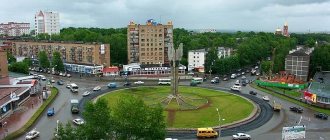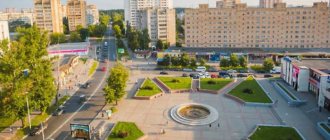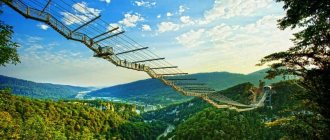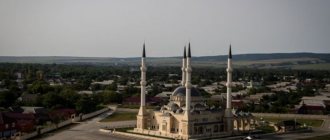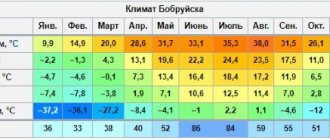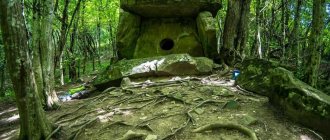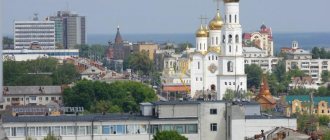Hello! Today we arrive in the next city of our trip “New Year trip 2019: Kostroma, Ivanovo and Suzdal”, namely Ivanovo! In this article I will tell you about our adventures in this city and show you a walking route around the center.
We started our acquaintance with Ivanovo from... the local zoo. We arrived there by car from Kostroma, and only then went to check into a hotel and get acquainted with the city.
We had enough time, because we left Kostroma around 11 am and were already in Ivanovo by lunchtime; we ended up at the hotel before dark!
Museum of Industry and Art
Museum of Industry and Art
Ivanovo
This mansion, made in the neoclassical style, belonged to the owner of a calico-printing factory and the famous collector Dmitry Burylin. Now the Museum of Industry and Art is located here, which is rightfully considered one of the best provincial museums in Russia. The halls on three floors create an excellent exhibition space for the unique collections collected and donated to the city by Burylin, from antiquity to the beginning of the 20th century.
Park named after V. Ya. Stepanova
Park named after V. Ya. Stepanova is located away from the Central Embankment, but is also located on the banks of the Uvodi. These 70 hectares of pine forest previously belonged to the factory owners Garelin and became part of the city only after the revolution of 1917, and in 1925 they turned into a cultural and recreation park. The park received its name from a local revolutionary and war hero, the head of the city council - V. Ya. Stepanov.
Park named after V. Ya. Stepanova
Every year the park is improved and prettier. Visitors are attracted here by the huge territory, where they can relax in peace and quiet from the hustle and bustle of the city. There are interesting metal sculptures here that deserve attention, in short - a great place for a relaxing walk. At the same time, the park has attractions for visitors of different ages: from children to adults. There is also a sports sector that operates all year round: in the summer they run, play tennis or badminton, and in the winter they go skiing and skating. There is also a beach and a boat station on site. The park constantly hosts mass entertainment events, holidays and festivals.
- Address: st. Smolnaya, 3.
- Opening hours: from 7:00 to 22:00 daily.
Museum of Ivanovo chintz
Museum of Ivanovo chintz
Ivanovo
Of course, it’s impossible to visit this museum if you’re in Ivanovo. Its exhibition is based on a unique textile collection numbering half a million items. The museum is located in the ancestral house of Dmitry Burylin, built at the beginning of the 20th century in the Art Nouveau style. In addition to Ivanovo calicoes, the museum presents the exhibition “Glory to Zaitsev. Life = creativity." By the way, the world-famous fashion designer was born in Ivanovo, graduated from a textile college here and began his creative path.
Sights of the city of Ivanovo
The Ivanovo Circus was founded in 1932, and the building was built by 1983; it is located in the city center - on Lenin Avenue, near the embankment of the Uvod River. Not long ago the circus was restored and operates in an updated form.
Detailed description and photo of the Ivanovo Circus
Museum of the Soviet Automotive Industry
The Ivanovo Museum of Soviet Cars opened its doors to visitors in 2014, created by an auto repair shop. The permanent exhibition collected for the museum presents cars from the legendary Soviet automobile factories: GAZ, ZIL, ZIS, ZIM, VAZ. Some of the most interesting examples are the modified GAZ-21 and the military GAZ-67B.
Cars for the museum were provided by private collectors. The museum has a souvenir shop that sells 1:43 scale models of Soviet classic cars.
Detailed description and photo of the Museum of the Soviet Automotive Industry
Ivanovo Regional Art Museum
The Museum of Fine Arts is located on the main street - Lenin Avenue, in a building from 1886 - an architectural monument, a former real school. The museum has more than 40 thousand storage units.
Thematic exhibitions: the art of Ancient Egypt and antiquity, the art of the East, Western European art, Russian art. Interactive excursions and intellectual games are held for children.
Detailed description and photo of the Art Museum in Ivanovo
Sorrow Church
The church in the historical quarter of Ivanovo - the former Dmitrovskaya Sloboda - is often and quite deservedly called the most beautiful church in the city center. The elegant five-domed church with a high bell tower fits organically into the urban landscape. However, the historical ensemble of the 19th - early 20th centuries has not survived: the Sorrow Church was blown up in 1976. The temple was revived in 1997–1999.
The blue and white church was built on the model of the previous church, but with some features: the interior spaces are more spacious due to the absence of additional vault supports; The church is higher - 35 meters.
Detailed description and photo of the Sorrow Church
Kazan Church
The white church with black domes in Ivanovo immediately stands out - this is the church in the name of the Kazan Icon of the Mother of God on the banks of the Uvod River. This building was erected in 1787 - initially as a calico-printing factory, and in 1810 it was rebuilt as a house of worship. It was consecrated only in 1903. During the Soviet years, the temple was closed and revived in 1991.
Another interesting detail: on the territory of the Kazan Church there is a natural spring with clean artesian water, which anyone can collect.
Detailed description and photo of the Kazan Church in Ivanovo
Bird house
This masterpiece of constructivism in Ivanovo resembles the outline of a bird from above - if you film the city from a drone or just look at a street map. If you find yourself in front of the building itself, it will be difficult to recognize the “bird” in it.
The asymmetrical building of 1928 at 53 Lenina Street, built according to the design of V.I. Pankov, houses a gymnasium.
Detailed description and photo of the Bird House
Horseshoe house
The building of an unusual semicircular shape in the suburban part of Ivanovo, just a block from the main avenue, dominates among the surrounding buildings. the semicircular façade faces the street, and the “ringed” courtyard faces the interior of the block. The horseshoe house was built in the 1930s according to the design of the architect A.I. Panov.
Shchudrovskaya tent
Shchudrovskaya tent
Ivanovo
This building is an example of real pre-Petrine chambers, only in miniature. The architectural monument appeared in the 17th century, and this is the oldest brick building in Ivanovo. For more than 300 years of history, there was a “cabin’s hut”, a printing manufactory, a warehouse for storing goods, and even living quarters. Now this place can be called one of the symbols of the city, which houses the museum collection.
Walking tour of Ivanovo
The center of Ivanovo is Revolution Square. The Ivanovo city administration is located there (a huge, tasteless box from socialist times), and in the park there is a monument to the fighters of the revolution (1975). Nearby, on the street. August 10, 36 - the only Ivanovo antiquity, called the Shchudrovskaya tent (white stone hut of the late 17th century). It was an official hut, in the modern sense of the village council of Ivanovo, where documents for serfs were kept. Then it turned into the workshop of the merchant Osip Shchudrov. In 1964, the Ivanovo authorities restored the original appearance of the hut. And next to it stands a monument to Arkady Severny (2010, sculptor Galim Dolmagambetov) - a criminal chansonnier, born Arkady Zvezdin (1939-1980), spent all his 17 school years in Ivanovo and only then left for Leningrad.
From Revolution Square we will head along the wide pedestrian Kokuy Boulevard. It was laid out on the site of a former ravine where a stream flowed (now it is in a sewer), and the level of the boulevard is still lower than the surrounding streets. It will lead us to another central square of the city - Pushkin, the appearance of which, at least on the right side, is completely determined by the monstrous half-mausoleum-half-crematorium (1937, architect Vlasov), which in fact is neither one nor the other, but the Palace of Arts, inside of which there are three theaters : musical, dramatic and puppet. Before that, two cathedrals stood on this site. The square is very large, there is a fountain, a square, benches, popularly it is called Pushka. There, in the corner, you will also see a curious landmark of Ivanovo - strange hut houses, but very tall, almost three-story. We could walk between the squares and along Lenin Avenue, and on the left we would see the Central Cinema (No. 9/1) in the Stalinist Empire style and the post office with a clock (No. 17).
Lenin Avenue goes here beyond the Uvod River (a tributary of the Klyazma) to the north across the Teatralny Bridge with beautiful lanterns. The river generally divides the city into two parts: to the south of it is the former village of Ivanovo, and to the north is the former Voznesensky Posad. It is very shallow and 20-30 meters wide, but there are thickenings and spills, and a reservoir has been created outside the city limits.
House-ship
House-ship
Ivanovo
As Vladimir Mayakovsky wrote in the twenties: “Moscow and Ivanovo... were built anew.”
An example of Soviet constructivism, this house is an integral symbol of Ivanovo. Architect Friedman turned a residential building for workers into a floating ship. One of the ends is shaped like the bow of a ship, and at the “stern” there is an observation tower.
What to see in Ivanovo in 1 day
Places worth visiting include pre-revolutionary churches and striking examples of Soviet constructivism. Some of the city's main attractions are “ordinary” residential buildings.
Workers' village
Two-story houses were built specifically for housing workers of the early USSR. The buildings were equipped with wiring and water supply for the first time. This area is a historical place that is truly worth visiting for lovers of old architecture.
Address: crossroads st. Leningradskaya and st. Krasnye Zori is the central square of the village.
Operating hours: 24 hours a day (outside viewing).
How to get there: bus 46, stop. “1st Workers’ Village” (Krasnykh Zori St.); bus 100, stop. "Workers' Village" (Leningradskaya St.).
Get directions
Temple of the Vladimir Icon of the Mother of God
The architects were inspired by the more ancient churches of Yaroslavl and Moscow. Inside, visitors are greeted by icons painted in the ancient Moscow style and a four-tiered iconostasis.
Address: Lezhnevskaya st., 118A.
Schedule: every day 08:00-19:00, Sunday 09:00-19:00
How to get there: to the stop “Ul. Velizhskaya", then walk to the right along the street. Lezhnevskaya: buses 7, 14, 33, 35, 100; trolleybuses 2, 7, 11; minibuses: 7, 25, 30, 31, 37, 39.
Get directions
Transfiguration Cathedral
Famous Ivanovo monument of religious architecture of the 19th century. The architect of the cathedral was the man who worked on the first Tretyakov building. There are oil frescoes on the walls inside; they are about a hundred years old.
Address: st. Kolotilova, 44.
Opening hours: daily 08:00-18:00.
How to get there: to the “Preobrazhensky Temple” stop, then walk along the street. Proletarskaya: buses 12, 32, 121, 150; trolleybus 1; minibus 24.
Get directions
Bird house (plane house)
The building has an unusual facade in the constructivist style, which is what the capital of the Ivanovo region is famous for as the third capital of socialism in the USSR. The vernacular names arose because the house's layout resembles that of a flying bird or airplane.
Address: Lenin Ave., 53.
How to get there: to the stop “Ul. Station", then walk towards the street. Ermak: buses 1, 2, 7, 29, 35, 130, 150; minibuses 2, 3K, 10, 30, 36, 131, 133.
Get directions
Church of the Kazan Icon of the Mother of God
Previously, the building was the building of a cotton mill. Now it is an active temple, which is a historical landmark of the city.
Address: ave. Sheremetevsky, 41.
Schedule: every day 08:00-18:00.
How to get there: Sokovsky Most stop: buses 2, 3, 12, 20, 32, 45, 120; trolleybuses 2, 6, 9, 11; minibuses 2, 17, 24, 30, 37, 39, 109, 131.
Get directions
A. Dühringer's estate
A pre-revolutionary house in Art Nouveau style, built for the Dühringer family. Today, other people live in the building. The estate is not very well preserved.
Address: Maria Ryabinina, 33.
Opening hours: 24 hours a day (inspection from outside).
How to get there: stop. “Sokolovsky Bridge”: buses 2, 12, 17, 25, 32, 45, 120; trolleybuses 2, 6, 9, 11; minibuses 2, 17, 24, 30B, 37, 39, 109, 131, 135.
Get directions
Vvedensky Convent
This place used to be just a church. In the 90s, a monastery appeared - one of the newest in Russia. The temple at the monastery attracts believers with the relics of the new martyrs.
Address: st. Basic, 23.
Schedule: Mon.-Fri. 06:30-20:00, Sat.-Sun. 07:30-20:00.
How to get there: stop. "Shuttle": buses 33, 38; trolleybuses 7, 8; minibuses 18, 24, 37, 38, 109, 129, 144.
Get directions
Ivanovo Musical Theater
Ivanovo Musical Theater
Ivanovo
Pushkin Square is one of the busiest places in Ivanovo, the city center. This is where the Ivanovo Musical Theater is located. And this is the only musical theater in the region.
The theater opened its first season in 1935. Today the repertoire of the Ivanovo Musical Theater is more diverse than ever. On stage - classical operetta, musical comedy, vaudeville, musical, ballet.
Monument to the fighters of the 1905 revolution
The contribution of the Ivanovo (or, more precisely, Ivanovo-Voznesensk) workers (after all, the city was previously called Ivanovo-Voznesensk) is great and comparable to the scale of the proletarian movement in Moscow or St. Petersburg. This merit was noted by V.I. Lenin, and his legendary phrase is immortalized in Ivanovo on a memorial plaque installed on one of the houses. In addition, there is a monument to the fighters of the revolution in the city, which preserves memories of the events of May 1905, when mass strikes of workers took place here. The large-scale monument was opened in 1975 on the 70th anniversary of the first Council. The authors of the composition are sculptor D. B. Ryabichev, architect E. I. Kutyrev with the participation of artist M. I. Malyutin.
Monument to the fighters of the 1905 revolution
The memorial is formed from two elements. The first is the sculptural group “Raising the Banner,” which depicts, as the title suggests, a worker receiving the revolutionary banner from the hands of a fallen comrade. The second element is a structure of four tall, blank dark slabs, symbolizing the dungeons of prisons. Fire seems to burst out of them - the flame of revolution, and inside there is an illuminated crystal - the embodiment of a beating heart.
- Address: Revolution Square, 3.
- Visiting hours: around the clock.


